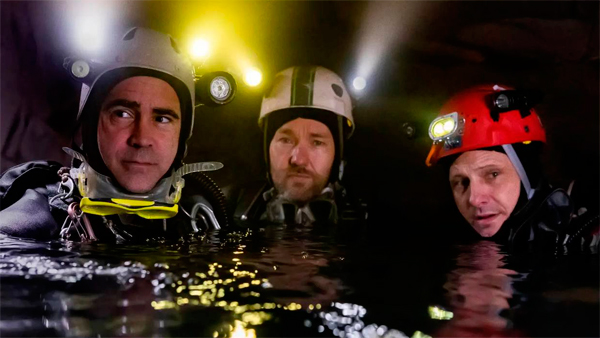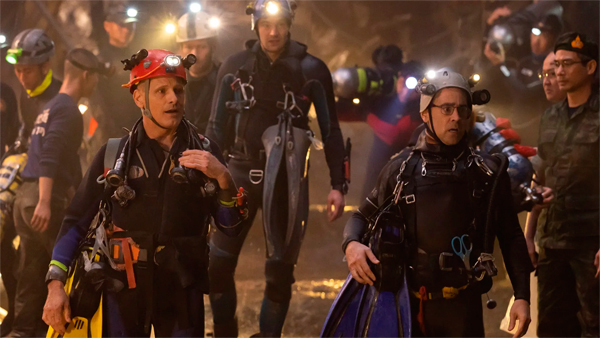The film starring Colin Farrell and Viggo Mortensen premieres on Prime Video this Friday, August 5.
thirteen lives narrates the shocking real case of the children of Thailand who were trapped in a cave in 2018. Everyone turned to try to save the 12 children who entered the cave with their young soccer coach and in which they were trapped for more than two weeks.
Ron Howard is in charge of directing this film with a main cast made up of Viggo Mortensen, Colin Farrell, Joel Edgerton and Tom Bateman, among others, and that comes to the streaming platform Prime Video This Friday, August 5.
For this reason, SensaCine has had the opportunity to interview Ron Howard, Oscar winner for A Beautiful Mindwhere he explained to us the difficulties of being able to adapt a true story as a film or how the actors decided to get so involved in the film that they also decided to do the underwater shots and not leave them to stunt doubles.
What is the hardest part of shooting a movie based on a true story?
Well, you always feel a great responsibility to bring out the truth of the story. You have to make it as convincing as possible. It’s a version of the real story, but with a script. So there is a fiction of certain scenes, but you are still trying to get to a fundamental truth. So that’s first and foremost.
In this case, I felt a great cultural responsibility in trying to convey what this fact means for Thailand and how the culture of the country really influenced it. And it was something that was first reported to me by Western divers. They told me that the spirituality of the region, the commitment to the idea of karma and the value of that they felt in some way.
They were creating a kind of energy and Western divers are not very spiritual. They are very practical. But everyone had to acknowledge that there was something unique about the energy surrounding this rescue, thanks mostly to the people of Thailand and their culture.
When watching the film it is difficult not to feel a little anguish for its protagonists. Did you have the same feeling when shooting it?
In truth, I did feel a lot of empathy for everything in general, since they are children trapped in a cave. The divers participating in the rescue knowing that it is almost impossible for there to be any chance of getting them out safely, the lack of love of the parents, the responsibilities of the volunteers who were there, the politicians involved…there were many versions of courage and risky decisions that were in the eyes of everyone. As I learned more about this story, I felt that audiences would find it fascinating.
Is there something that really impacted you about the rescue but that you couldn’t address in the film?
Anything about the rescue that was shocking I found a way to get it into the movie. But I think the frustration that was there. There were a lot of people trying to help. People exploring other caverns and cave tunnels. There were also people who brought ideas that in the end did not work. Like a half dozen different groups experimenting with new ideas.
There were a lot of really cool and interesting details that there just wasn’t room for. None of it was really shocking, but I thought it was all fascinating. So I think all the versions of this story that have been told and will be told are all relevant because it’s a tremendously interesting and intricate story. This is the story told through my filter and I hope people find it engaging, moving and interesting.
Prime Video
Did you get to talk to the people who were involved in the rescue?
I spoke with several. With the divers, the engineer who went up the mountain, and other people who were actually going to be characters in our movie, but who were willing to be available to talk. And, of course, a lot of research was done. The investigators met with whoever was needed. Then, on top of everything else, the cast members reached out to people who had been close to the operation. Many details were learned in this way.
How was the process of shooting inside the cave?
We couldn’t work on the actual cave and COVID-19 didn’t allow us to go to Thailand when we started shooting. We were eventually able to go and shoot some scenes, which I’m very grateful for. So we built the cave, the mouth of the cave and all the interiors. All of that was decorated.
Molly Hughes, who is our production designer, did great. I tried to make it as authentic as possible. And when it came to the underwater moments, we worked very closely with the divers so they could describe to us in detail which sections of the cave created the most problems for them and where the greatest risks and challenges lay. And those were the parts of the cave that, of course, we built and staged.
The actors had to do extensive training for shooting those underwater scenes, right?
None of the actors are strangers to that kind of physical preparation for a role. And they had all been divers before. They had to re-certify as such due to insurance and other issues. And then I started working with the real divers who came to Australia.
They worked as technical advisers, not only on diving in the team, but also on the environment. Like the base camp and everything that was observed about the mechanics of the rescue and others. But as our actors began to learn the diving techniques, they came to me and, led by Viggo Mortensen, said, ‘We want to do it all. Since we have now learned the techniques, we can do it quite safely.’
I told them there was no time, but they kept explaining that they would be working overtime. Whatever was necessary, but they wanted to do it. And that was something I could never have asked of them. But when they were offered, he brought a lot to the film. So I am very grateful to them. They even ended up doing some of the photography because they adapted so much down there that sometimes in those tight spaces it was frankly easier to give one of them a camera and let them photograph the other diver than to get a camera operator inside.
Did you have any problems shooting any of the scenes in the film?
I just had a lot of worries, but no big problems. The shooting in the cave was slower than I expected and much more difficult on the part of the actors. I’ve done a lot of shooting underwater before, but when you start putting people in those tight spaces, even if they’re decorated, you have to be very careful. You have to be very thoughtful and methodical. That was difficult.

Prime Video
It was also quite a challenge trying to recreate the base camp environment. It required a lot of research. Our assistant directors and the team in general had to rehearse with people. They couldn’t just walk in and pick a prop and make it compelling. We had to take a look at the news footage and see what people were doing.
And that’s just for field work. But we were afraid of like 25 or 30 scenarios that we could do in a very authentic way. It was important to me to make you feel like you were really there. The other big challenge was the language. I don’t speak Thai and had to.
I not only delegated my co-producers who were Thai and the cinematographers, but also the actors. And many were actors from northern Thailand, who have their own dialect and culture. They started explaining to me that some things in the script were culturally inconsistent with the way things would be said, the way they pray, or how they treat authority.
So we had to look at that very carefully and thoughtfully. And they had to trust me that I wanted to get the truth out. I didn’t want this to be a Hollywood version. I wanted the Thai audience to see it and feel like it could have been made by a Thai film crew. Which in a way it was because a lot of the crew were Thai and so were the actors.
If you want to be up to date and receive the premieres in your email, sign up for our Newsletter

